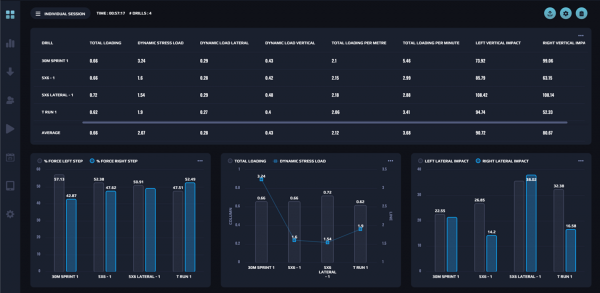
05 Mar Data-Driven Excellence: Harnessing Accelerometer Metrics with STATSports GPS Monitoring
Athlete performance monitoring has the ability to revolutionize how coaches and sports scientists understand and optimize athlete training. Speed and distance tracking have long been synonymous with GPS units, however, the accelerometer provides another pivotal component to the device.
But what exactly is an accelerometer?
An accelerometer is a sensor that measures acceleration forces exerted on it by movements in three-dimensional space.
This vital piece of technology enables the precise measurement of acceleration forces across lateral (x-axis), vertical (y-axis), and anterior-posterior axis (z-axis), offering comprehensive insights into an athlete’s movements, exertions, and biomechanics.
Tri-axial accelerometer-derived metrics allow practitioners to delve deep into the intricacies of athlete performance. These advanced sensors capture intricate data points (measured in G-force) on force dynamics, revealing the intensity, directionality, and magnitude of an athlete’s exertions across three pivotal axes: lateral, vertical, and anterior-posterior.
In activities like sprinting, cutting, or jumping, accelerometers precisely measure changes in acceleration and deceleration, distinguishing between different actions with remarkable accuracy.
For instance, accelerometers can detect accelerations associated with sprinting, changes in direction, or throwing motions, facilitating detailed performance analysis and tactical evaluation.
STATSports’ Accelerometer-based Metrics
The STATSports Apex device’s tri-axial accelerometer boasts an impressive array of metrics that delve deep into the intricacies of athlete performance.
Among these, Dynamic Loading metrics across lateral, vertical, and anterior-posterior axes stand out as pivotal indicators of accumulated force changes in specific directions.
These metrics encapsulate the sum of all instantaneous forces, offering a comprehensive view of an athlete’s exertions.
Additionally, by monitoring the cumulative load of the acceleration forces experienced by an athlete, through the summation metric of Total Loading, or in a specific plane of motion using the metrics of Lateral, Vertical, and Anterior-Posterior Impact, the sum of acceleration forces in each direction offers a holistic understanding of exertions in different planes. This aids in workload management and injury prevention.
Step symmetry can be identified, and discrepancies identified using the Step Balance metric, which is determined by identifying average vertical force distribution discrepancies between the left and right foot.
This helps pinpoint potential asymmetries in an athlete’s movement patterns, aiding in corrective measures and injury prevention strategies.
Utilising the magnitude values of the tri-axial accelerometer, Impact metrics highlight moments of high physical stress or high-intensity activity, allowing coaches and trainers to manage and optimise training progams.

Figure 1 – Sonra Desktop software displaying a selection of accelerometer derived metrics.
Enhancing Performance with Accelerometer Metrics
Through regular, dedicated monitoring of the metrics that the accelerometer provides us with, a range of benefits are attainable for practitioners in their day-to-day workflows, and for athletes as we strive to maximize performances through data-driven decision making:
- Customised Training Programs: Insights from these metrics enable coaches to tailor training programs based on specific force directions, optimizing athlete performance.
- Performance Enhancement: By tracking loading in specific axes, athletes can work on refining their technique and movement efficiency. Optimising force application in different directions may lead to improved athletic performance and reduced energy expenditure.
- Injury Reduction: Identifying imbalances or high-impact events helps in designing injury reduction strategies to enhance athlete robustness.
- Rehabilitation and Recovery: Following an injury, monitoring accelerometer loading in three axes aids in the design of rehabilitation programmes, where a gradual return to performance can be planned with the ability to ensure the restoration of balance and symmetry in force exertion.
- Load Management: Understanding the cumulative acceleration forces in different axes aids in managing an athlete’s workload, preventing overexertion and fatigue.
- Technique Refinement: Step balance metrics facilitate identifying and correcting movement asymmetries, refining techniques, and reducing injury risks.
Accelerometer metrics offer a specific perspective on athlete performance, capturing detailed insights into movement dynamics and biomechanical patterns.
Whether examined independently or in tandem with GPS speed and distance metrics, they provide valuable information for coaches and sports scientists.
When analysed in isolation, accelerometer data reveals the intensity, directionality, and magnitude of an athlete’s movements, aiding in technique refinement and workload management.
Conversely, when combined with GPS data, such as speed and distance tracking, accelerometer metrics offer a comprehensive view of an athlete’s overall performance.
This holistic approach enables practitioners to tailor training programs, optimise technique, and mitigate injury risks more effectively, ultimately enhancing athletic development and success.
Summary
The incorporation of accelerometer metrics within STATSports GPS monitoring devices represents a pivotal tool in athlete performance assessment and enhancement.
By harnessing these metrics, derived from comprehensive data on force dynamics across multiple axes, teams can revolutionize training methodologies, enhance performance, and safeguard athlete well-being in a targeted and data-driven manner.
As we continue to explore the capabilities of accelerometer technology, it’s evident that its integration presents opportunities in sports performance analysis and performance enhancement that are not commonly integrated into practitioner workflows worldwide, promising to unlock the full potential of athletes on a global scale.
Sonra watch is also a key component of how STATSports users manage rehab and recovery like in benefit 4 of the accelerometer use above. For more on the Sonra watch Sonra Watch: Perfect for RTP, Rehab & Conditioning Sessions – STATSports